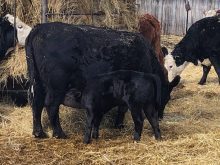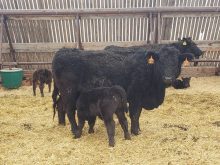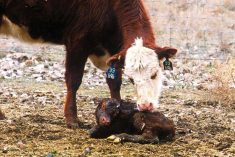Calving season is here and even though “hard pulls” — difficult deliveries or C-sections — are rare these days, they do happen.
The calving cow needs our attention and help the most when there is some form of malpresentation. This is one time where we can make a big difference by recognizing something isn’t right, correcting it and being able to deliver the calf in a timely manner. Many malpresentations are caused by twins, and making a difference here can save two calves.
The Beef Cattle Research Council video titled “How to Intervene in a Difficult Calving” gives a great review on how to prep the cow for examination. The six-minute video shows how proper cleaning of the cow and using gloves with lubrication provide a double benefit of protecting your arms, as well as the vagina from abrasions. Always have a good supply of obstetrical sleeves on hand.
Read Also

Harvest wraps up and fall work begins
At the Eppich famly ranch in western Saskatchewan, the fall harvest was successful with few breakdowns, cows and calves have been sorted and a new tractor has arrived
While being gentle, keeping the rear area of the cow clean increases her chances of a safe delivery and for rebreeding.
The video goes over the equipment you need, showing how to double-chain around the calf’s ankles and the proper angles to pull it out.
The video also goes into the two most common malpresentations — head back or leg back. If identified quickly enough, quick intervention can result in a live calf.
The video uses animation to show how to correct these conditions, and a veterinarian shows how to do the correction in a simulator cow. Being able to look down into the simulator shows how to do the correction, as you can see exactly what the vet’s hands are doing.
Decisions need to be made
The video also shows how to put on the calf snare when a head back is encountered. The BCRC website has a written description of this same procedure, which then leads to the “calving decision tree.” This walks a producer through the delivery process, from stages one and two labour, to signs of distress, to determining if there is a problem that needs correction, when to pull the calf, and when to call the vet.
The great thing about the calving decision tree is explaining whether to change the decision from when you first intervene, depending on what you find as you weave your way through the process. There is even a distinction on what to do if an experienced or inexperienced person is attending to the delivery. Most farmers know their ability level. That helps to decide what they can handle themselves or if time has elapsed to the point where a veterinarian should be called.
A delayed birth due to a malpresentation is where we lose most calves these days. Being able to recognize malpresentations and deal with them promptly often results in a live calf. Recognizing your limits and either getting help from an experienced neighbour or your veterinarian is a decision up to you.
I recommend printing the calving decision tree (see PDF below) and posting it in the calving barn. It is also a great tool for teaching someone new at the calving experience. On the back of the decision tree are several cutaways showing what the most common malpresentations of a calf looks like inside the cow. This helps give you a visual of what you may be dealing with and then act to correct it. For example, when using a calf puller up against the cow, how it acts like an anchor which allows you to get the angle right to deliver a calf with the least resistance.
Time is of the essence, particularly with a backwards calf. Not long after the tail head is presented, the cord is pinched and will break so then it is imperative to get the calf out. This is the only time a calf is pulled relatively quickly. Even those quite experienced at calving will pick up a few pointers from the video narrative and reviewing the calving flow chart.
Most breeding programs and most purebred beef producers usually target genetics that combine calving ease with good growth of the calves afterward. Fortunately, today fetal oversizes that result in a hard pull or C-section are quite rare. Most birth malpresentations are generally beyond our control and are generally a fluke.
With good observational skills you can correct and save most of the calves.
Here’s hoping the 2023 calving season is or was a great one and that malpresentations were at a minimum. Malpresentations are simply a puzzle that often can be solved if a producer has the correct information and guidance. If applied in a timely manner, your action usually results in a live calf.















